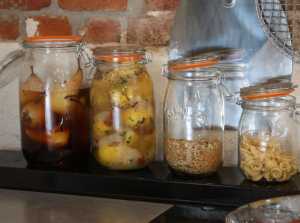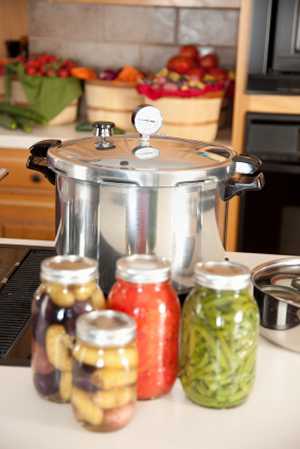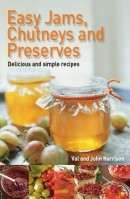Bottles / Jars for Home Bottling / Canning
 You need solid, thick glass jars like those that are sold under the Kilner or Le Parfait brands in the UK or known as Mason Jars in the US.
You need solid, thick glass jars like those that are sold under the Kilner or Le Parfait brands in the UK or known as Mason Jars in the US.
If you already have jars, check the condition – especially around the lip. Any chips or cracks make them unusable. Rubber seals that go between lid and jar must be in good condition as well.
These sealing rings do deteriorate and can stretch with time which prevents a good, safe seal. They are relatively inexpensive to replace
Metal lids and screw rings / bands should be clean and corrosion free. A smear of Vaseline on the outside is good for preventing corrosion in store.
The most useful sizes of jars are half quart or quart size (500 ml or 1 litre). There are two main types on the market:
- Spring-Clip Top bottles – Normally have a glass top and a rubber ring between the lid and the rim of the bottle. This helps to form a complete seal when the bottle has been processed.
- Screw Band bottles – Usually have a glass or metal lid fitted with a rubber ring kept in place by a band which screws on. During processing (except by the oven method) this band should be loosely screwed on and then tightened while the bottle is cooling.

Pressure Bottler Canner
Pressure Canner
If you just want to produce a couple of bottles of tomatoes, for example, then you you’ll be able to cope using an ordinary pressure cooker such as the Prestige Hi Dome.
However, if you’re seriously into bottling you’ll need something with a larger capability. In Britain these larger pressure canners are usually imported from the USA. The volume is quoted in quarts which are just a little less than litres (1 US quart = 0.95 Litres)
The Hi Dome has a capacity of 6 litres but the US canning machines range from 16 quarts (15litres) to 25 quarts (23 litres) A reasonable large pressure canner can be found for about twice the price of a pressure cooker but with 3 to 4 times the capacity.
The difference between being able to process 5 one litre bottles and 2 one litre bottles at a time is well worth the additional cost of a specialist machine.
Large Flat Bottomed Pan or Purpose Made Bath Canner – for water bath method
If you only occasionally need a water bath for canning then you’ll probably find an existing large jam pan adequate but if you get seriously into canning then it’s worth investing in a purpose made water bath with a rack and greatly increase how many jars can be processed in a session, saving both time and energy.
Bottling Utensils
- Thermometer – Special high temperature thermometers are available for bottling and jam making and, although not essential, make life a lot easier.
- Long Handled Wooden Spoon – For packing fruit into larger bottles.
- Bottling Tongs – Not essential but helps when handling hot bottles, especially when removing them from pressure cookers or water baths.
- Oven mitts – you are going to be handling hot pans and jars
- Large Baking Tray – For the oven method of bottling to stand the bottles on.
- Wire Cooling Tray or Heatproof Mats – to put hot bottles on when cooling.
- Trivet or Wire Tray for Base of Pans – this stops the direct heat from cracking the jars during processing.
- Timer – or a watch / clock with a second hand for timing.
More On Bottling (Canning)
- Bottling or Home Canning Your Produce – Introduction, History, Safety Tips
- Methods of Home Bottling / Canning
- Bottling or Home Canning – Preparation of Fruit and Vegetables
- Oven Dry Pack Bottling (Canning) Method
- Oven Wet Pack Bottling (Canning) Method
- Slow Water Bath Bottling (Canning) Method
- Fast Water Bath Bottling (Canning) Method
- Pressure Bottling (Canning)


